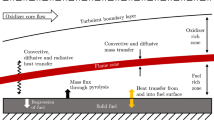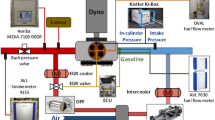Abstract
This study examines a multi-tube pulse detonation engine (PDE) which has a type of constant volume combustion. We designed and made the multi-tube PDE and then conducted an experiment in various operating frequencies and equivalence ratios. First, experiments with operating frequencies of 40, 80, 120, 160, and 200 Hz resulted in an average thrust and specific impulse 23.14 N and 42.34 s. The next experiment resulted in the equivalence ratio varying from 0.81 to 1.38, which resulted in an average thrust and specific impulse 22.36 N and 40.11 s. The average detonation velocity was 8% lower than that calculated according to C–J theory. The incidence ratios of the detonation wave were stable with the exception of the operating frequency of 200 Hz. However, at 200 Hz, the incidence ratio was less than 50%. We assumed that a low fill fraction occurred for this problem. The thrust of the PDE increased with the operating frequency. However, the thrust increase was at a lower rate than in previous studies, because of a lost thrust output result from the slow response time of the load cell amplifier.















Similar content being viewed by others
Abbreviations
- t :
-
Time
- \(\tau \) :
-
Angle percentage occupied at \(360^{\circ }\)
- f :
-
Operating frequency
- \(\dot{{m}}\) :
-
Mass flow rate
- P :
-
Absolute pressure
- R :
-
Gas constant
- A :
-
Cross sectional area
- T :
-
Kelvin temperature
- \(\gamma \) :
-
Specific heat ratio
- \(\varPhi \) :
-
Equivalence ratio
- V :
-
Volume
- \(\varPsi \) :
-
Fill fraction
- F :
-
Thrust
- I :
-
Impulse
- \(I\_{\mathrm{sp}}\) :
-
Specific impulse
- g :
-
Gravitational acceleration
- \({\epsilon }\) :
-
Incidence ratio
- N :
-
Number of times
- \(\hbox {supply}\) :
-
In time of supply condition
- \(\hbox {oper}\) :
-
Operating condition
- \(\hbox {tank}\) :
-
Reservoir tank
- \(\hbox {a}\) :
-
Ambient condition
- 0:
-
Total condition
- \(\hbox {x}\) :
-
Any chemical species
- \(\hbox {tot}\) :
-
In case of total time
- \(\hbox {f}\) :
-
Fuel
- \(\hbox {o}\) :
-
Oxidizer
- \(\hbox {stoic}\) :
-
Stoichiometry
- \(\hbox {tube}\) :
-
Tube of combustor
- \(\hbox {cyc}\) :
-
Per a one cycle
- \(\hbox {avg}\) :
-
Time averaged
References
Turns SR (1996) An introduction to combustion. McGraw-Hill, New York
Lee JH (2008) The detonation phenomenon. Cambridge University Press, Cambridge
Kim JM, Niyasdeen M, Han HS, Oh SJ, Choi JY (2017) Research activities on PGC propulsion based on RDE, part I: basic studies. J Korean Soc Propuls Eng 21(5):97–107. https://doi.org/10.6108/KSPE.2017.21.5.097
Roy G, Frolov S, Borisov A, Netzer D (2004) Pulse detonation propulsion: challenges, current status, and future perspective. Prog Energy Combust Sci 30(6):545–672. https://doi.org/10.1016/j.pecs.2004.05.001
Bussing T, Bratkovich T, Hinkey J (1997) Practical implementation of pulse detonation engines. AIAA Pap 2748:1997. https://doi.org/10.2514/6.1997-2748
Barr L (2008) Pulse detonation engine flies into history. Air Force Material Command. http://www.af.mil/News/Article-Display/Article/123534/pulsed-detonation-engine-flies-into-history/. Accessed 12 Aug 2015
Kasahara J, Hasegawa A, Nemoto T, Yamaguchi H, Yajima T, Kojima T (2007) Thrust demonstration of a pulse detonation rocket TODOROKI. In: Proceedings of 43rd AIAA/ASME/SAE/ASEE joint propulsion conference and exhibit, Cincinnati, OH
Naples A (2011) Recent progress in detonation. In: Proceedings of international workshop on detonation for propulsion, Busan, Korea
Sakurai T, Yuasa S (2011) Development of pulse detonation combustor for 1 kW-class micro gas turbine. In: Proceedings of international workshop on detonation for propulsion, Busan, Korea
Matsuoka K, Takagi S, Kasahara J, Morozumi T, Kashiwazaki T, Fujiwara Y, Matsuo A, Funaki I (2014) Study on a rotary-valved four-cylinder pulse detonation rocket: six degree-of-freedom flight measurement. In: Proceedings of 52nd aerospace sciences meeting, National Horbor, Maryland
Matsuoka K, Yageta J, Nakamichi T, Kasahara J, Yajima T, Kojima T (2011) Inflow-driven valve system for pulse detonation engines. J Propulsi Power 27(3):597–607. https://doi.org/10.2514/1.47421
Matsuoka K, Esumi M, Ikeguchi KB, Kasahara J, Matsuo A, Funaki I (2012) Optical and thrust measurement of a pulse detonation combustor with a coaxial rotary valve. Combustd Flame 159(3):1321–1338. https://doi.org/10.1016/j.combustflame.2011.10.001
Morozumi T, Sakamoto R, Kashiwazaki T, Kasahara J, Matsuoka K, Matsuo A, Funaki I (2014) Study on a rotary-valved four-cylinder pulse detonation rocket: thrust measurement by ground test. In: Proceedings of 52nd aerospace sciences meeting, National Harbor, Maryland
Matsuoka K, Sakamoto R, Morozumi T, Kasahara J, Matsuo A, Funaki I (2015) Thrust performance of rotary-valved four-cylinder pulse detonation rocket engine. Trans Jpn Soc Aeronaut Sp Sci 58(4):193–203. https://doi.org/10.2322/tjsass.58.193
Anderson JD (1990) Modern compressible flow: with historical perspective. McGraw-Hill, New York
Wu MH (2007) Development and experimental analyses of meso and micro scale combustion systems. Ph.D. Mechanical Engineering, The Pennsylvania State University, PA
Niyasdeen M, Oh SJ, Kim KS, Choi JY (2015) Quasi-steady state simulation of rotating detonation engine. Int J Aeronaut Sp Sci 16(4):548–559. https://doi.org/10.5139/IJASS.2015.16.4.548
Stoddard W, Gutmark E J (2014) Comparative numerical study of RDE injection designs. In: Proceedings of 52nd aerospace sciences meeting, AIAA SciTech Forum, National Harbor, MA
Hayashi A K, Kimura Y, Yamada T, Yamada E, Kindracki J, Dzieminska E, Wolanski P, Tsuboi N, Tangirala V, Fujiwara T(2009) Sensitivity analysis of Rotating detonation engine with a detailed reaction model. In: Proceedings of 47th AIAA aerospace sciences meeting including the new horizons forum and aerospace exposition, aerospace sciences meetings, Orlando, FL
Tae YK, Ji HK, Jeong YC (2014) Theoretical performance prediction program of pulse detonation engines. J Korean Soc Aeronaut Sp Sci 42(7):552–560. https://doi.org/10.5139/JKSAS.2014.42.7.552
Acknowledgements
This work was carried out with support from the Space Core Technology Research Grants (NRF-2013M1A3A3A02042430) of the National Research Foundation (NRF) of Korea, which was funded by the Ministry of Science, ICT and Future Planning (MSIP) of the Korean Government. It was also supported in part by the Advanced Research Center Program (NRF-2013R1A5A1073861) of the NRF, which is funded by the MSIP contracted through the Advanced Space Propulsion Research Center at Seoul National University.
Author information
Authors and Affiliations
Corresponding author
Additional information
An earlier version of this paper was presented at APISAT 2017, Seoul, Korea, October 2017.
Rights and permissions
About this article
Cite this article
Kim, JM., Han, HS. & Choi, JY. The Experimental Study about the Effect of Operating Conditions on Multi-tube Pulse Detonation Engine Performance. JASS 19, 89–99 (2018). https://doi.org/10.1007/s42405-018-0026-2
Received:
Revised:
Accepted:
Published:
Issue Date:
DOI: https://doi.org/10.1007/s42405-018-0026-2




